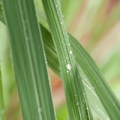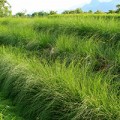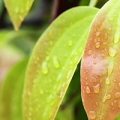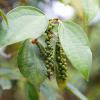Organic Lemongrass Essential Oil – Cymbopogon Citratus
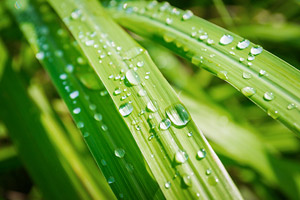 Lemongrass essential oil (Cymbopogon citratus) is derived from a versatile plant that has been used for countless centuries throughout Malaysia, Philippines, Indonesia and India in folk medicine and cuisine.
Lemongrass essential oil (Cymbopogon citratus) is derived from a versatile plant that has been used for countless centuries throughout Malaysia, Philippines, Indonesia and India in folk medicine and cuisine.
The fragrant leaves are still used to treat a wide range of illnesses, sometimes using methods which are specific only to a certain area.
For example, in the Philippines lemongrass leaves are applied directly to the forehead to relieve migraines and headaches, whereas in India infusions of the leaves are taken internally to ease the same condition.
Traditional uses of lemongrass
Lemongrass herb is used to bring relief to a multitude of conditions including bronchitis, coughs, colds, flu, pneumonia, arthritis, rheumatism, muscular aches and gynaecological diseases. It also makes an effective insect repellant.
Most commonly it is taken as a tea to treat digestive disorders and to combat malaria and fevers. In Ayurvedic medicine the grass is also used in preparations to treat epilepsy and leprosy, expel parasitic worms, and as an antidote against poisons. It is also used extensively in traditional Chinese medicine.
Today, lemongrass essential oil is produced in large quantities for use in the cosmetic, perfumery and pharmaceutical industries, and finds its way into a diverse range of products such as disinfectants, detergents, polishes, mosquito-repellent lotions, shampoos and soaps. Lemongrass is included in every aromatherapist’s collection of essential oils due to its popular aroma and wide range of therapeutic uses.
However, there are two distinct species of Cymbopogon grown to produce essential oil of lemongrass. The first is Cymbopogon citratus originating in Malaysia and traded as West Indian lemongrass oil, and the other is Cymbopogon flexuosus which is native to East India and referred to in commerce as East Indian lemongrass oil. Most of the oil derived from C. flexuosus is produced in Kerala State, India, and a significant proportion of this is reserved for local consumption. To bolster world demand for lemongrass oil, this species is also cultivated in Indonesia and Madagascar.
General description
Cymbopogon citratus is a perennial, tufted, aromatic grass with plentiful robust cane-like stems that are covered with waxy-powdery secretion. Below the stems are short, ring-shaped rhizomes, and an extensive rootstock that is surprisingly shallow for a tall grass. The smooth stems eventually develop into tall, strap-shaped, tapering linear leaves that arch outwards gracefully forming a dense rounded clump of foliage up to 2 metres across. Mature plants may reach up to 3 metres in height and usually survive 4 or 5 years.
The fibrous aromatic leaves are medium to light green in colour, releasing a fresh lemon-like aroma when crushed between the fingers. The essential oil content of the leaves varies along its length with the highest concentration occurring at the tip of the leaf, and young leaves also contain more oil than the mature ones.
Harvesting and extraction
In many countries the leaves can be harvested every 3 or 4 months over the lifetime of the crop, and this period is governed by the weather, cultivar of the plant, and skill of the grower. Harvesting takes place on sunny days whenever possible since cloudy weather can reduce the content of oil in the leaves, and after cutting the crop is left to wilt for a few days to reduce the water content.
Cymbopogon citratus is generally steam distilled, whereas in India extraction of C. flexuosus is usually by hydro-distillation using the same type of crude apparatus that has been employed for hundreds of years. The spent charge is usually recycled as fuel, mulch or cattle fodder, and in India it is also processed as paper pulp.
The yielded essential oil is yellow to dark amber and has a strong, fresh, grassy-lemon aroma with herbaceous aspects. The fragrance of C. flexuosus is slightly less herbaceous and marginally sweeter than C. citratus.
Benefits of lemongrass essential oil
Lemongrass essential oil strengthens connective tissue, tones the skin, normalises overactive sebaceous glands and reduces open pores making it perfect for balancing oily skin and clearing acne.
Used in massage, lemongrass oil is very good at easing the pain associated with arthritis and rheumatism. Its fortifying action restores muscle tone, eases muscle pain, and relieves mental fatigue bringing clarity and focus to the mind.
Few essential oils possess a more potent anti-fungal action than lemongrass, making it ideal for athlete’s foot and candida, and the high levels of a component in the oil called citral means it is also a powerful antiseptic.
When 12 antiviral essential oils were tested in vitro against Herpes simplex (HSV-1) at the department of Microbiology in Japan, lemongrass essential oil (C. citratus) demonstrated the strongest antiviral activity of them all with complete inhibition at a concentration of only 0.1%.
This result revealed lemongrass oil to be 10 times more effective than even tea tree, ravensara, peppermint or eucalyptus oils, which all needed a concentration of 1.0% to achieve the same result. However, don’t use lemongrass essential oil undiluted on the skin because it may cause mild skin sensitization or irritation.
Lemongrass is a middle note that adds punch and lift to most aromatherapy blends, and mixes very nicely with basil, bergamot, cedar atlas and virginian, clary sage, frankincense, geranium, jasmine, juniper berry, lavender, neroli, palmarosa, patchouli, rose, rosemary, sandalwood, tea tree, vanilla and vetiver.
See Quinessence Lemongrass Essential Oil
Copyright © Quinessence Aromatherapy Ltd 2020.

